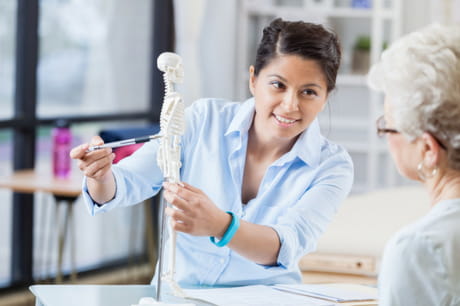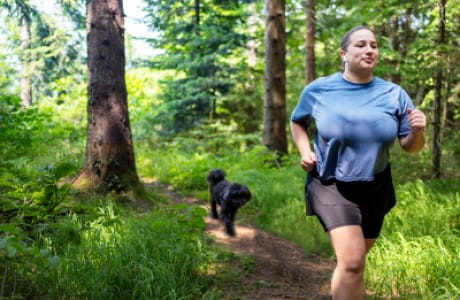Here’s your recipe for healthy bones
,
Bones play a big role in the body - they provide structure, protect organs, anchor muscles and store calcium. When children are growing, we're focused on making sure their diets and activities promote healthy bones. But here's something you may not have considered: Adults also need to make sure they're taking steps to ensure their bones stay healthy as they age.
"Your bones are always changing, with new bone being made and old bone getting broken down," explained Geisinger rheumatologist Thomas P. Olenginski, MD. When you're young, your body is able to make new bone faster than it breaks down, increasing your bone mass. However, most people reach their peak bone mass by the time they're 30.
"As you age, you lose slightly more bone mass than you gain. This becomes problematic because low bone mass can lead to osteoporosis, which causes bones to become weak and brittle," Dr. Olenginski said.
About 54 million Americans have osteoporosis and low bone mass, placing them at increased risk for osteoporosis and broken bones, according to the National Osteoporosis Foundation.
However, osteoporosis doesn't have to be in your future - you can do things now, including quitting smoking, to ensure you have healthy bones and plenty of bone mass "in your bank." Here are the ingredients you need for healthy bones.
Calcium
Calcium in a necessary mineral - it builds bones and keeps them healthy in addition to helping blood clot, nerves send messages, and muscles contract.
"Each day, you lose calcium through your skin, nails, hair, sweat, urine and feces. But your body can't produce new calcium on its own, which is why it's so important to make sure you get enough calcium in your diet," Dr. Olenginski said.
An ongoing lack of calcium plays a big role in the development of osteoporosis.
"When your body doesn't have enough calcium, it's taken from your bones," Dr. Olenginski said. "That's why not getting enough calcium over time contributes to diminished bone density, early bone loss and an increased risk of fractures."
Women age 50 and younger need about 1,000 mg of calcium and women age 51 and older need 1,200 mg of calcium daily. Men 70 and younger need 1,000 mg of calcium per day and men 71 and older need about 1,200 mg.
Food is the best source of calcium. Some great sources of calcium include different dairy products, including low-fat and non-fat milk, yogurt and cheese. Almonds and green leafy vegetables like kale and broccoli are also high in calcium.
"If you're not getting enough calcium from your diet or you need more than your diet can provide, your doctor may recommend a calcium supplement," Dr. Olenginski said.
Vitamin D
Focusing on getting enough calcium isn't enough for your bones - you also need to make sure you're getting enough vitamin D.
"Your body needs vitamin D to help it absorb calcium and use it to strengthen and build your bones," Dr. Olenginski said. "If you're not getting enough vitamin D, you may be at risk of losing bone, having lower bone density and breaking bones as you age."
Like calcium, you get vitamin D through your diet. But your body also makes vitamin D naturally when your skin is exposed to sunlight.
"You skin makes vitamin D from the ultra violet (UV) rays in sunlight. Your body is able to store vitamin D and use it later," Dr. Olenginski said. "The amount of this vitamin your skin makes depends on the time of day, season, latitude, your skin pigmentation and other factors."
Some people don't get enough vitamin D during the reduced sunlight hours of winter, or because they're focused on avoiding the sun due to skin cancer concerns. However, you only need a minimal amount of sun exposure to boost your vitamin D production - about 10 minutes a day.
"You can make up for lack of sunlight by eating foods that provide you with vitamin D, including fatty fish like wild-caught mackerel, salmon and tuna. Some milk, other dairy products, soy milk, orange juice and cereals have vitamin D added to them - find out by checking their labels."
Men and women under the age of 50 need 400 to 800 international units (IU) of vitamin D daily. People 50 and older need 800 to 1,000 IU per day.
"If you're not getting enough vitamin D from the sun or in your diet, or you already have osteoporosis, your doctor may recommend adding a daily vitamin D supplement. But first check any other supplements you're taking to see if they contain vitamin D - many multivitamins and calcium supplements also contain vitamin D," Dr. Olenginski said.
Exercise
You may think that exercise may put you at risk of getting injured, but it is a key component of building healthy bones.
"Bones simply last longer if you stress them more," Dr. Olenginski said. "Weight-bearing exercises cause your body to resist gravity and stimulate cells in your bones to make new bone, effectively strengthening it."
Exercise not only causes muscles to pull on the bone to cause increased bone strength, but it also increases your flexibility, strengthens your muscles, and gives your joints more support. All of this together reduces your chances of falling.
"For people who have already been diagnosed with osteoporosis, exercise is just as important - it can help prevent further bone loss," Dr. Olenginski explained.
Weight-bearing and strengthening exercises that can help keep your bones strong include walking, yoga, aerobics, jogging, dancing, climbing stairs, tai chi, and racquet sports.
"In order for exercise to increase your bone strength, try to get a mix of aerobic, weight bearing and resistance exercises in throughout the week," Dr. Olenginski said.
Osteoporotic fractures and complications can occur in many post-menopausal women and in older men.
"It's very important to discuss your bone health with your doctor," Dr. Olenginski said. "A fracture risk assessment - which includes testing bone density, understanding a patient's history of fractures, and using a risk calculation tool - is critical to identify patients who will benefit from prescription osteoporosis medications, which are shown to reduce osteoporotic fractures and complications."
"Your bones are always changing, with new bone being made and old bone getting broken down," explained Geisinger rheumatologist Thomas P. Olenginski, MD. When you're young, your body is able to make new bone faster than it breaks down, increasing your bone mass. However, most people reach their peak bone mass by the time they're 30.
"As you age, you lose slightly more bone mass than you gain. This becomes problematic because low bone mass can lead to osteoporosis, which causes bones to become weak and brittle," Dr. Olenginski said.
About 54 million Americans have osteoporosis and low bone mass, placing them at increased risk for osteoporosis and broken bones, according to the National Osteoporosis Foundation.
However, osteoporosis doesn't have to be in your future - you can do things now, including quitting smoking, to ensure you have healthy bones and plenty of bone mass "in your bank." Here are the ingredients you need for healthy bones.
Calcium
Calcium in a necessary mineral - it builds bones and keeps them healthy in addition to helping blood clot, nerves send messages, and muscles contract.
"Each day, you lose calcium through your skin, nails, hair, sweat, urine and feces. But your body can't produce new calcium on its own, which is why it's so important to make sure you get enough calcium in your diet," Dr. Olenginski said.
An ongoing lack of calcium plays a big role in the development of osteoporosis.
"When your body doesn't have enough calcium, it's taken from your bones," Dr. Olenginski said. "That's why not getting enough calcium over time contributes to diminished bone density, early bone loss and an increased risk of fractures."
Women age 50 and younger need about 1,000 mg of calcium and women age 51 and older need 1,200 mg of calcium daily. Men 70 and younger need 1,000 mg of calcium per day and men 71 and older need about 1,200 mg.
Food is the best source of calcium. Some great sources of calcium include different dairy products, including low-fat and non-fat milk, yogurt and cheese. Almonds and green leafy vegetables like kale and broccoli are also high in calcium.
"If you're not getting enough calcium from your diet or you need more than your diet can provide, your doctor may recommend a calcium supplement," Dr. Olenginski said.
Vitamin D
Focusing on getting enough calcium isn't enough for your bones - you also need to make sure you're getting enough vitamin D.
"Your body needs vitamin D to help it absorb calcium and use it to strengthen and build your bones," Dr. Olenginski said. "If you're not getting enough vitamin D, you may be at risk of losing bone, having lower bone density and breaking bones as you age."
Like calcium, you get vitamin D through your diet. But your body also makes vitamin D naturally when your skin is exposed to sunlight.
"You skin makes vitamin D from the ultra violet (UV) rays in sunlight. Your body is able to store vitamin D and use it later," Dr. Olenginski said. "The amount of this vitamin your skin makes depends on the time of day, season, latitude, your skin pigmentation and other factors."
Some people don't get enough vitamin D during the reduced sunlight hours of winter, or because they're focused on avoiding the sun due to skin cancer concerns. However, you only need a minimal amount of sun exposure to boost your vitamin D production - about 10 minutes a day.
"You can make up for lack of sunlight by eating foods that provide you with vitamin D, including fatty fish like wild-caught mackerel, salmon and tuna. Some milk, other dairy products, soy milk, orange juice and cereals have vitamin D added to them - find out by checking their labels."
Men and women under the age of 50 need 400 to 800 international units (IU) of vitamin D daily. People 50 and older need 800 to 1,000 IU per day.
"If you're not getting enough vitamin D from the sun or in your diet, or you already have osteoporosis, your doctor may recommend adding a daily vitamin D supplement. But first check any other supplements you're taking to see if they contain vitamin D - many multivitamins and calcium supplements also contain vitamin D," Dr. Olenginski said.
Exercise
You may think that exercise may put you at risk of getting injured, but it is a key component of building healthy bones.
"Bones simply last longer if you stress them more," Dr. Olenginski said. "Weight-bearing exercises cause your body to resist gravity and stimulate cells in your bones to make new bone, effectively strengthening it."
Exercise not only causes muscles to pull on the bone to cause increased bone strength, but it also increases your flexibility, strengthens your muscles, and gives your joints more support. All of this together reduces your chances of falling.
"For people who have already been diagnosed with osteoporosis, exercise is just as important - it can help prevent further bone loss," Dr. Olenginski explained.
Weight-bearing and strengthening exercises that can help keep your bones strong include walking, yoga, aerobics, jogging, dancing, climbing stairs, tai chi, and racquet sports.
"In order for exercise to increase your bone strength, try to get a mix of aerobic, weight bearing and resistance exercises in throughout the week," Dr. Olenginski said.
Osteoporotic fractures and complications can occur in many post-menopausal women and in older men.
"It's very important to discuss your bone health with your doctor," Dr. Olenginski said. "A fracture risk assessment - which includes testing bone density, understanding a patient's history of fractures, and using a risk calculation tool - is critical to identify patients who will benefit from prescription osteoporosis medications, which are shown to reduce osteoporotic fractures and complications."

Content from General Links with modal content




